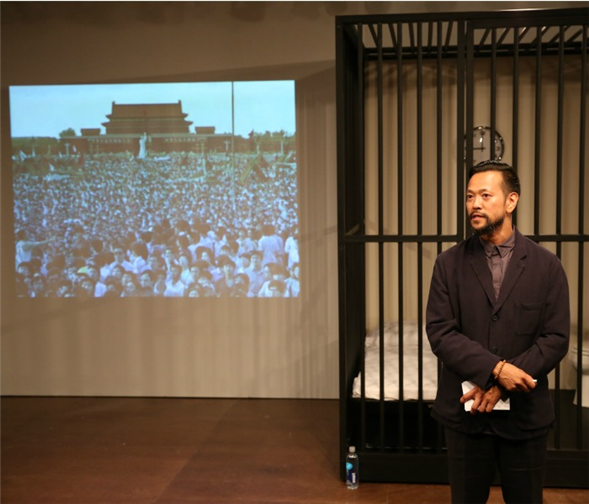Translate Page

Christopher Chen's slippery play challenges audiences to constantly reevaluate what they're experiencing
---
How do you create a piece of subversive political artwork so secretive that it can escape the acute surveillance of the watchful Chinese government? And then how do you make all traces of it disappear?
These questions underlie the work of Chinese dissident artist Lin Bo, whose art, activism, and imprisonment set the stage for Christopher Chen's Caught, currently in a PlayCo production at La MaMa.
As both artist and activist, Lin Bo resists the authorities, doing everything he can to elude the censors who would shut him down and shut him up. In the interest of such evasion, he creates ephemeral pieces that are difficult or even impossible to pin down physically. As Lin Bo tells the audience: "I painted calligraphy on buildings scheduled to be destroyed. I made sculptures from found objects in busy urban centers…I did not document any of it. They were to disappear completely."
Like Lin Bo's art, Caught itself is an exercise in creation and disappearance. Concrete, familiar settings -- a New York art gallery, a magazine office -- are set up only to disappear, gradually shifting the audience's expectations and undermining their assumptions throughout the play.
"The whole production is constantly in the process of changing and transforming," says Chen.
Yet dynamic transformation is not simply an elaborate structural game in Caught. It is also a potent means of showing the very real challenges and confusions that come with cultural encounters. When a well-meaning American curator interviews another Chinese artist about her work, the conversation becomes increasingly fraught, plagued by ambiguities and misunderstandings. Throughout their dialogue, it is not set pieces but paradigms that are transformed.
These progressions of physical and conceptual transformations unmoor Caught from any single point of view. "You don't really know if what [the artist] is saying is the play's point of view, or the person's point of view, or if it's just the product of a language barrier," Chen says about this scene. "What she's actually saying turns out to be kind of startling. But the provocative questions she raises are meant to simulate a challenging encounter with someone from another culture. This is not an encounter you would necessarily have with someone, but it simulates the real gulf that needs to be engaged with. Especially in racial matters, you can't ever land on something that is comfortable. When you're dealing with people or other cultures, the only thing you can do is to be in a constant engagement -- in a constant place of challenge. The challenge is the point."
The result in Caught is that the audience is disoriented, made to question where to draw the lines between art and reality, truth and perception, politics and culture, empowerment and disempowerment.
"One of the fun things I realized while writing this is how much power there is in words alone," Chen says. "Especially in terms of who has the authority to dictate reality. It's fun to think about in this Trumpian world, where you really can -- just through words -- reshape reality. I really think that's what theatre is about, too."
---
Lynda Paul is a dramaturg and writer based in New Haven, CT.
Photos by Carol Rosegg. Top image: Louis Ozawa Changchien in Caught.
TDF MEMBERS: Browse our discounted tickets to theatre, dance, and concerts.